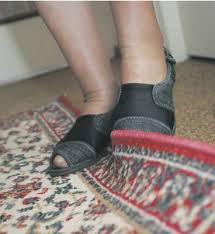
Flat feet, also known as pes planus, is a common condition where the arches of the feet collapse, causing the entire sole of the foot to come into contact with the ground. This condition can lead to discomfort, pain, and even strain on the ligaments and tendons that support the arch. Fortunately, orthopedic shoes have emerged as a valuable solution to alleviate the discomfort associated with flat feet. In this article, we'll explore the intricacies of flat feet, how orthopedic shoes can provide much-needed support, and how they help realign the feet, reducing ligament strain.
Understanding flat feet
Flat feet can be a congenital condition or develop over time due to various factors, including injury, aging, or excessive stress on the feet. People with flat feet often experience:
Find YOUR ideal care home NOW!
- Pain and discomfort, particularly in the arch and heel areas.
- Tenderness along the inner side of the foot.
- Overpronation, where the feet roll inward when walking or running.
The role of orthopedic shoes
Orthopedic shoes are specially designed to address various foot conditions, including flat feet. They offer multiple benefits for those with fallen arches:
1. Built-in arch support: Orthopedic shoes come with enhanced arch support. This additional support helps to maintain the arch's natural shape and reduces strain on the ligaments and tendons that support the arch.
2. Motion control: Orthopedic shoes often incorporate motion control features. These features help control overpronation by providing stability, reducing the risk of ankle and knee issues that can result from excessive inward rolling of the foot.
3. Alleviating pain: By promoting the correct alignment of the feet and reducing overpronation, orthopedic shoes can alleviate pain and discomfort associated with flat feet.
4. Even weight distribution: These shoes are designed to distribute your body weight evenly across your feet, reducing the strain on the arch and promoting proper foot alignment.
Selecting the right orthopedic shoes
When searching for orthopedic shoes to manage flat feet, consider the following:
1. Arch support: Ensure that the shoes have ample arch support built in to provide the necessary lift and cushioning for your fallen arches.
2. Proper fit: Get your feet properly measured and choose shoes that provide enough room for your toes without being too loose.
3. Cushioning: Look for shoes with cushioning in the insole and heel area to absorb impact and reduce pain.
4. Supportive design: Consider the design and structure of the shoes to ensure they provide stability and motion control.
Key Features of Orthopedic Shoes for Flat Feet
| Feature | Benefit | Recommended For |
|---|---|---|
| Built-in Arch Support | Helps maintain the natural foot shape and reduces strain | People with fallen arches or plantar fasciitis |
| Motion Control Design | Prevents overpronation and enhances stability | Individuals with excessive inward foot rolling |
| Cushioned Insoles | Absorbs impact and reduces stress on joints | Those experiencing foot pain and discomfort |
| Wide Toe Box | Prevents unnecessary pressure on the toes | People prone to bunions or calluses |
| Shock Absorption | Minimizes foot strain during walking or running | Active individuals or those with joint issues |
Flat feet can be a challenging condition, but it doesn't have to limit your mobility or cause ongoing discomfort. Orthopedic shoes are a practical solution for individuals with fallen arches, as they offer support, alleviate pain, and help realign the feet. By choosing the right pair of orthopedic shoes and focusing on arch support, motion control, and comfort, you can effectively manage flat feet and enjoy greater comfort and mobility in your everyday life.
FAQ:
1. What are the main symptoms of flat feet?
Flat feet can cause pain in the arches and heels, excessive foot fatigue, swelling, and knee or back discomfort due to improper weight distribution.
2. How do orthopedic shoes help with flat feet?
Orthopedic shoes provide built-in arch support, motion control, and shock absorption to minimize pain and stabilize foot alignment.
3. Can flat feet cause other health issues?
Yes, untreated flat feet can lead to knee, hip, and lower back pain due to misalignment and improper posture.
4. How can I tell if I overpronate?
Overpronation is when your feet roll excessively inward while walking or running. It can be diagnosed by checking wear patterns on shoes or consulting a podiatrist.
5. Are custom orthotics necessary for flat feet?
Custom orthotics can be beneficial for severe flat feet cases, but high-quality orthopedic shoes often provide sufficient support for most individuals.
6. What should I look for in shoes if I have flat feet?
Choose shoes with strong arch support, firm heel counters, cushioned insoles, and motion control features to prevent overpronation.
7. Can exercises help strengthen flat feet?
Yes, exercises like toe curls, arch lifts, and calf stretches can improve foot strength and reduce discomfort caused by flat feet.
8. Is walking barefoot bad for flat feet?
Walking barefoot on hard surfaces can strain the arches and worsen symptoms. Using supportive shoes or orthotics is recommended.
9. Where can I find orthopedic shoes designed for flat feet?
You can find orthopedic shoes in specialty footwear stores, podiatry clinics, and online retailers offering medically approved footwear.
Need help finding a care home?
Senior Home Plus offers free personalized guidance to help you find a care facility that suits your health needs, budget, and preferred location in the UK.
Call us at 0203 608 0055 to get expert assistance today.
Do you need a care home for yourself or your loved one?
Search for Care Homes by Region
| East Midlands | Eastern | Isle of Man |
| London | North East | North West |
| Northern Ireland | Scotland | South East |
| South West | Wales | West Midlands |
| Yorkshire and the Humber |
Share this article :
Latest posts
You are looking for an establishment for your loved one ?
Get availability & prices
Fill in this form and receive
all the essential information
We would like to inform you of the existence of the opposition list for telephone canvassing.









